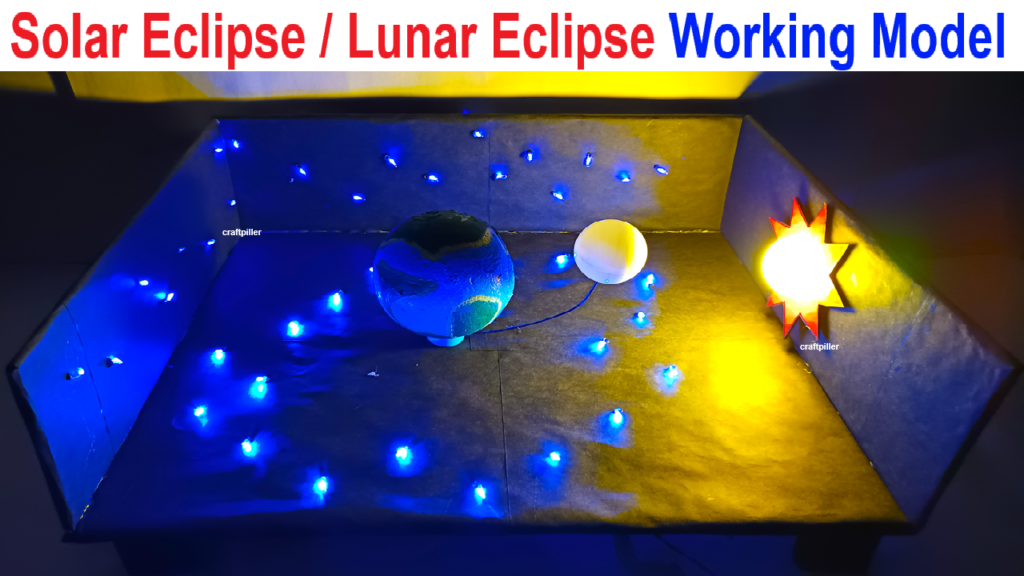This project will demonstrate both a Solar Eclipse and a Lunar Eclipse using cardboard, LED lights, thermocol balls, 9V battery, and a slow-running motor. The model will visually show how the moon, Earth, and Sun align during these natural phenomena.

Materials Required:
Cardboard (for base and structural support)
LED Light (for the Sun)
Thermocol Balls (for the Sun, Earth, and Moon)
9V Battery & Wires (for powering the LED light and motor)
Slow-running Motor (for rotating the Earth and Moon)
Glue Gun & Tape
Paint or Color Paper (for decorating Sun, Moon, and Earth)
Scissors & Markers (for labels)
Steps to Make the Model:
1. Create the Base
Take a large piece of cardboard to act as the base of the model.
Draw or paint the Sun (yellow) at one side of the board.
Draw or paint the Earth (blue and green) in the center.
Leave space for the Moon’s orbit around the Earth.
2. Build the Sun, Earth, and Moon
Sun:
- Use a large thermocol ball for the Sun.
- Paint it yellow or orange to represent the Sun.
- Attach an LED light inside the Sun (this will simulate the Sun’s illumination).
- Use a small hole to thread wires for the 9V battery.
Earth:
- Use a medium thermocol ball for Earth.
- Paint it blue and green to represent the oceans and landmasses.
- The Earth will rotate on its axis to show the Earth’s rotation.
Moon:
- Use a small thermocol ball for the Moon.
- Paint it gray or white to represent the Moon’s surface.
- Attach the Moon to the Earth using a small wire or stick, and make it rotate around Earth.
3. Set Up the Rotating Mechanism for Earth and Moon
- Attach the slow-running motor to a fixed point on the cardboard base.
- Connect the motor to the Earth so that it can rotate. The motor should slowly rotate the Earth on its axis, making the Moon orbit around it.
- The Moon’s rotation should be slower than the Earth’s, so it moves around the Earth at a slower pace.
4. Position the LED Light for the Sun
- Place the LED light so that it shines on the Earth and Moon, simulating the sunlight.
- Use the 9V battery to power the LED light, and make sure it’s positioned at a fixed point to represent the Sun’s position.
5. Solar Eclipse
- As the Moon rotates around the Earth, it will occasionally align between the Earth and Sun, blocking the Sunlight.
- This will create a solar eclipse effect. The shadow of the Moon will fall on the Earth.
- The model should be set up so that the Moon blocks the Sun’s light at some point in its orbit, simulating a solar eclipse.
6. Lunar Eclipse
- When the Earth aligns between the Sun and Moon, the Earth will cast a shadow on the Moon.
- This will simulate a lunar eclipse, where the Moon is darkened as it enters the Earth’s shadow.
- As the Earth rotates, it will position itself between the Moon and Sun, and the Moon will turn dark to simulate a lunar eclipse.

